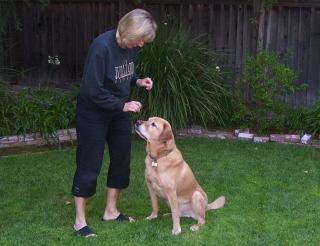Why I love watching Victoria Stillwell train dogs on “It’s Me or the Dog”

I am not a professional dog trainer or an animal behaviorist and I don’t even have a television. So, why would I write about Victoria Stilwell and her inspirational dog training methods on “It’s Me or the Dog”? Because when the producers of the show contacted me for permission to play the music of Through a Dog’s Ear on the show, I wanted to make sure she used dog training skills that I supported. It only took three short online video segments before I completely fell in love with her training style and now regularly watch her show to help expand my dog handling skills, and more importantly, improve my relationship with Sanchez, my yellow Lab.
Top 10 reasons I love Victoria Stilwell’s training methods:
10. She loves dogs and turns training into play and fun, hence making it enjoyable and stress free for the dog and the humans involved.
9. All of her training methods are safe to be used at home by anyone.
8. She communicates equally well with people as with dogs.
7. She is extremely patient, calm, and loving with dogs.
6. She believes and understands that a true leader can teach and lead without force.
5. She doesn’t use choke or pronged pinch collars on dogs.
4. She knows how to instill confidence in dogs by finding out why a dog is behaving the way they are and then teaching the dog to learn to feel differently about the root cause of their behavior.
3. She is a master at desensitizing dogs to stressful situations by controlling distance and rewards.
2. She sets dogs up for success and minimizes failures by only putting them in situations that they can successfully handle.
1. Drum Roll please …..
In watching and studying “It’s Me or the Dog”, I find at least two major similarities between Victoria’s training methods and Through a Dog’s Ear, the first music clinically demonstrated to relieve anxiety issues in dogs. Victoria’s training methods are based on a proven science. According to a research article published by Applied Animal Behavior Science in February 2009, “Ultimately, reward-based training is less stressful or painful for the dog, and hence, safer for the owner (than confrontational training methods).
[i]
Similarly, Through a Dog’s Ear is also science and research-based. It had already been proven by Deborah Wells that classical music calmed dogs in shelters.
[ii]
Susan Wagner, a veterinary neurologist and co-author of the book, Through a Dog’s Ear, conducted a research study with over 150 dogs in shelters and then in homes.
[iii]
Four hours of varying types of classical music were tested on dogs for relaxation response and also for the relief of anxiety issues (separation, sound phobias, excitement with visitors, etc.)
The second major similarity between Through a Dog’s Ear and Victoria Stilwell’s training method leads to the number one reason I enjoy watching her work with dogs:
1. Victoria is extremely talented at getting into the dog’s mind and thinking and feeling like them, understanding body language, space, and feelings.
In just a matter of seconds, she seems to sense and feel what the dog is feeling. Similarly, we came up with the title, Through a Dog’s Ear, because we wanted people to become more aware of their dog’s sound environment and how it was affecting canine health and behavior, as well as their own. (Click here for tips on taking a sonic inventory of your environment. http://www.throughadogsear.com/sonic_inventory.htm)
Even I am always becoming attuned to ways that I can become a more sound aware dog guardian.
Stay tuned on Saturday, August 22 @ 9 PM when Victoria plays Music to Calm your Canine Companion from Through a Dog’s Ear to help calm an out of control dog on It’s Me or the Dog (Animal Planet).
[i]
M.E. Herron et al. / Applied Animal Behaviour Science 117 (2009) 47–54
[ii]
Wells, D. L., et al. "The Influence of Auditory Stimualtion on the Behaviour of Dogs Housed in a Rescue Shelter." Animal Welfare 11 (2002): 385-393
[iii]
Wagner, S., et al. BioAcoustic Research & Development Canine Research Summary (2004). http://throughadogsear.com/research.htm




